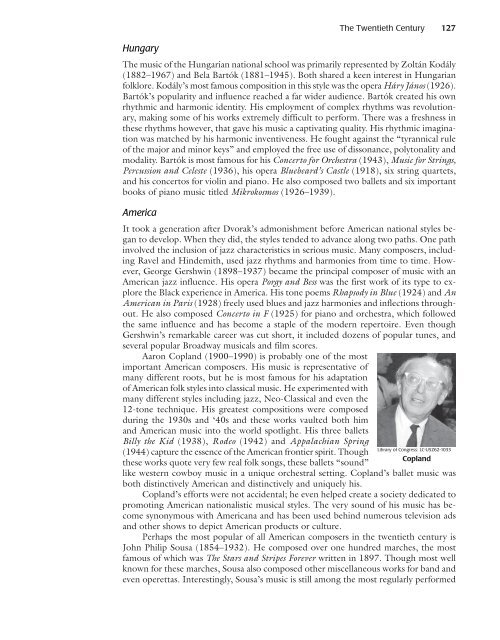Composer Profile - Activefolio
Composer Profile - Activefolio
Composer Profile - Activefolio
You also want an ePaper? Increase the reach of your titles
YUMPU automatically turns print PDFs into web optimized ePapers that Google loves.
Hungary<br />
The Twentieth Century 127<br />
The music of the Hungarian national school was primarily represented by Zoltán Kodály<br />
(1882–1967) and Bela Bartók (1881–1945). Both shared a keen interest in Hungarian<br />
folklore. Kodály’s most famous composition in this style was the opera Háry János (1926).<br />
Bartók’s popularity and influence reached a far wider audience. Bartók created his own<br />
rhythmic and harmonic identity. His employment of complex rhythms was revolutionary,<br />
making some of his works extremely difficult to perform. There was a freshness in<br />
these rhythms however, that gave his music a captivating quality. His rhythmic imagination<br />
was matched by his harmonic inventiveness. He fought against the “tyrannical rule<br />
of the major and minor keys” and employed the free use of dissonance, polytonality and<br />
modality. Bartók is most famous for his Concerto for Orchestra (1943), Music for Strings,<br />
Percussion and Celeste (1936), his opera Bluebeard’s Castle (1918), six string quartets,<br />
and his concertos for violin and piano. He also composed two ballets and six important<br />
books of piano music titled Mikrokosmos (1926–1939).<br />
America<br />
It took a generation after Dvorak’s admonishment before American national styles began<br />
to develop. When they did, the styles tended to advance along two paths. One path<br />
involved the inclusion of jazz characteristics in serious music. Many composers, including<br />
Ravel and Hindemith, used jazz rhythms and harmonies from time to time. However,<br />
George Gershwin (1898–1937) became the principal composer of music with an<br />
American jazz influence. His opera Porgy and Bess was the first work of its type to explore<br />
the Black experience in America. His tone poems Rhapsody in Blue (1924) and An<br />
American in Paris (1928) freely used blues and jazz harmonies and inflections throughout.<br />
He also composed Concerto in F (1925) for piano and orchestra, which followed<br />
the same influence and has become a staple of the modern repertoire. Even though<br />
Gershwin’s remarkable career was cut short, it included dozens of popular tunes, and<br />
several popular Broadway musicals and film scores.<br />
Aaron Copland (1900–1990) is probably one of the most<br />
important American composers. His music is representative of<br />
many different roots, but he is most famous for his adaptation<br />
of American folk styles into classical music. He experimented with<br />
many different styles including jazz, Neo-Classical and even the<br />
12-tone technique. His greatest compositions were composed<br />
during the 1930s and ‘40s and these works vaulted both him<br />
and American music into the world spotlight. His three ballets<br />
Billy the Kid (1938), Rodeo (1942) and Appalachian Spring<br />
(1944) capture the essence of the American frontier spirit. Though<br />
these works quote very few real folk songs, these ballets “sound”<br />
Library of Congress: LC-USZ62-1033<br />
Copland<br />
like western cowboy music in a unique orchestral setting. Copland’s ballet music was<br />
both distinctively American and distinctively and uniquely his.<br />
Copland’s efforts were not accidental; he even helped create a society dedicated to<br />
promoting American nationalistic musical styles. The very sound of his music has become<br />
synonymous with Americana and has been used behind numerous television ads<br />
and other shows to depict American products or culture.<br />
Perhaps the most popular of all American composers in the twentieth century is<br />
John Philip Sousa (1854–1932). He composed over one hundred marches, the most<br />
famous of which was The Stars and Stripes Forever written in 1897. Though most well<br />
known for these marches, Sousa also composed other miscellaneous works for band and<br />
even operettas. Interestingly, Sousa’s music is still among the most regularly performed



